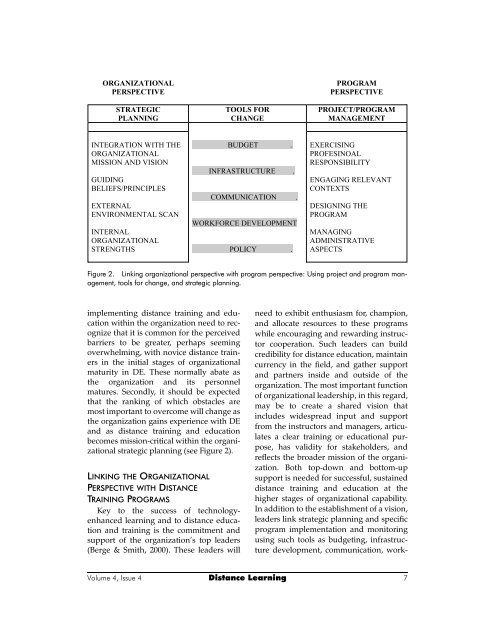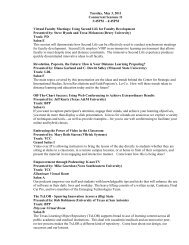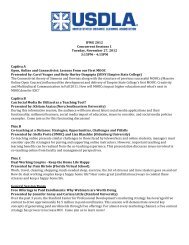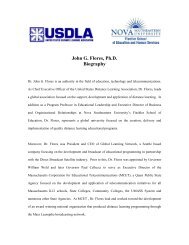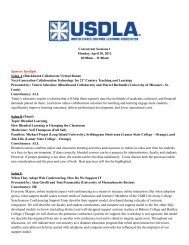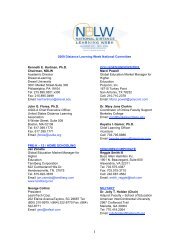United States Distance Learning Association
United States Distance Learning Association
United States Distance Learning Association
- No tags were found...
You also want an ePaper? Increase the reach of your titles
YUMPU automatically turns print PDFs into web optimized ePapers that Google loves.
ORGANIZATIONAL<br />
PERSPECTIVE<br />
STRATEGIC<br />
PLANNING<br />
TOOLS FOR<br />
CHANGE<br />
PROGRAM<br />
PERSPECTIVE<br />
PROJECT/PROGRAM<br />
MANAGEMENT<br />
INTEGRATION WITH THE<br />
ORGANIZATIONAL<br />
MISSION AND VISION<br />
GUIDING<br />
BELIEFS/PRINCIPLES<br />
EXTERNAL<br />
ENVIRONMENTAL SCAN<br />
INTERNAL<br />
ORGANIZATIONAL<br />
STRENGTHS<br />
BUDGET .<br />
INFRASTRUCTURE .<br />
COMMUNICATION .<br />
WORKFORCE DEVELOPMENT<br />
POLICY .<br />
EXERCISING<br />
PROFESINOAL<br />
RESPONSIBILITY<br />
ENGAGING RELEVANT<br />
CONTEXTS<br />
DESIGNING THE<br />
PROGRAM<br />
MANAGING<br />
ADMINISTRATIVE<br />
ASPECTS<br />
Figure 2. Linking organizational perspective with program perspective: Using project and program management,<br />
tools for change, and strategic planning.<br />
implementing distance training and education<br />
within the organization need to recognize<br />
that it is common for the perceived<br />
barriers to be greater, perhaps seeming<br />
overwhelming, with novice distance trainers<br />
in the initial stages of organizational<br />
maturity in DE. These normally abate as<br />
the organization and its personnel<br />
matures. Secondly, it should be expected<br />
that the ranking of which obstacles are<br />
most important to overcome will change as<br />
the organization gains experience with DE<br />
and as distance training and education<br />
becomes mission-critical within the organizational<br />
strategic planning (see Figure 2).<br />
LINKING THE ORGANIZATIONAL<br />
PERSPECTIVE WITH DISTANCE<br />
TRAINING PROGRAMS<br />
Key to the success of technologyenhanced<br />
learning and to distance education<br />
and training is the commitment and<br />
support of the organization’s top leaders<br />
(Berge & Smith, 2000). These leaders will<br />
need to exhibit enthusiasm for, champion,<br />
and allocate resources to these programs<br />
while encouraging and rewarding instructor<br />
cooperation. Such leaders can build<br />
credibility for distance education, maintain<br />
currency in the field, and gather support<br />
and partners inside and outside of the<br />
organization. The most important function<br />
of organizational leadership, in this regard,<br />
may be to create a shared vision that<br />
includes widespread input and support<br />
from the instructors and managers, articulates<br />
a clear training or educational purpose,<br />
has validity for stakeholders, and<br />
reflects the broader mission of the organization.<br />
Both top-down and bottom-up<br />
support is needed for successful, sustained<br />
distance training and education at the<br />
higher stages of organizational capability.<br />
In addition to the establishment of a vision,<br />
leaders link strategic planning and specific<br />
program implementation and monitoring<br />
using such tools as budgeting, infrastructure<br />
development, communication, work-<br />
Volume 4, Issue 4 <strong>Distance</strong> <strong>Learning</strong> 7


